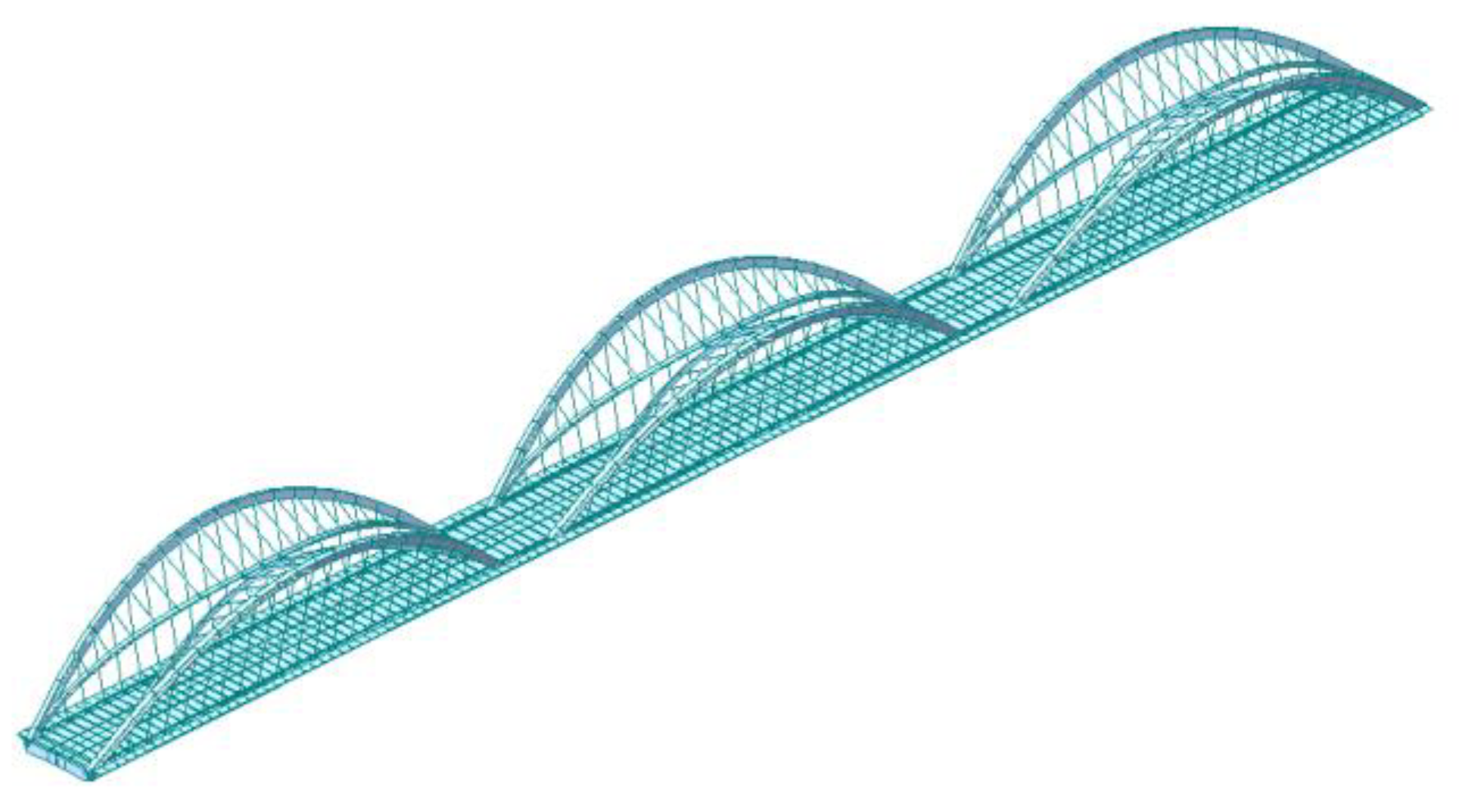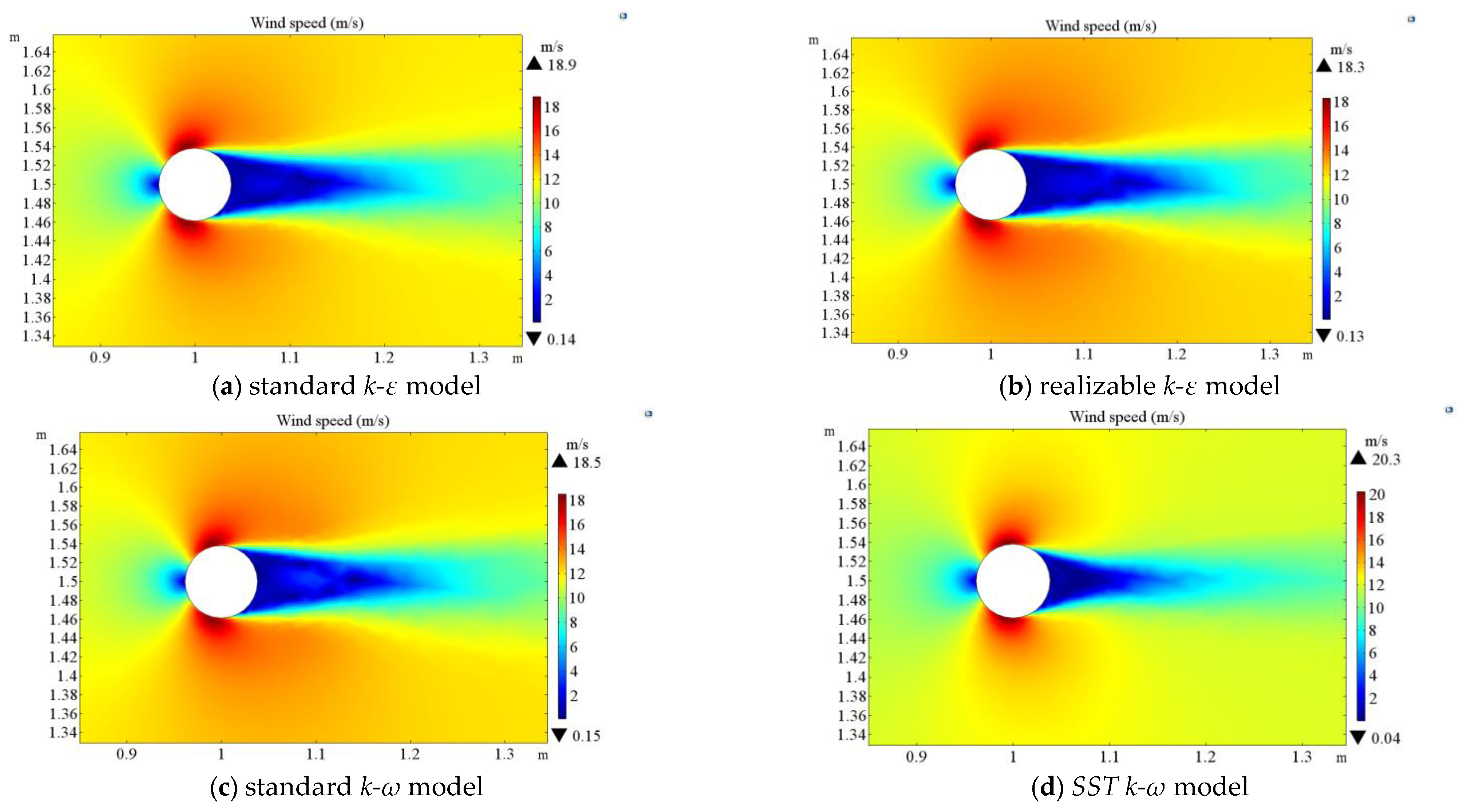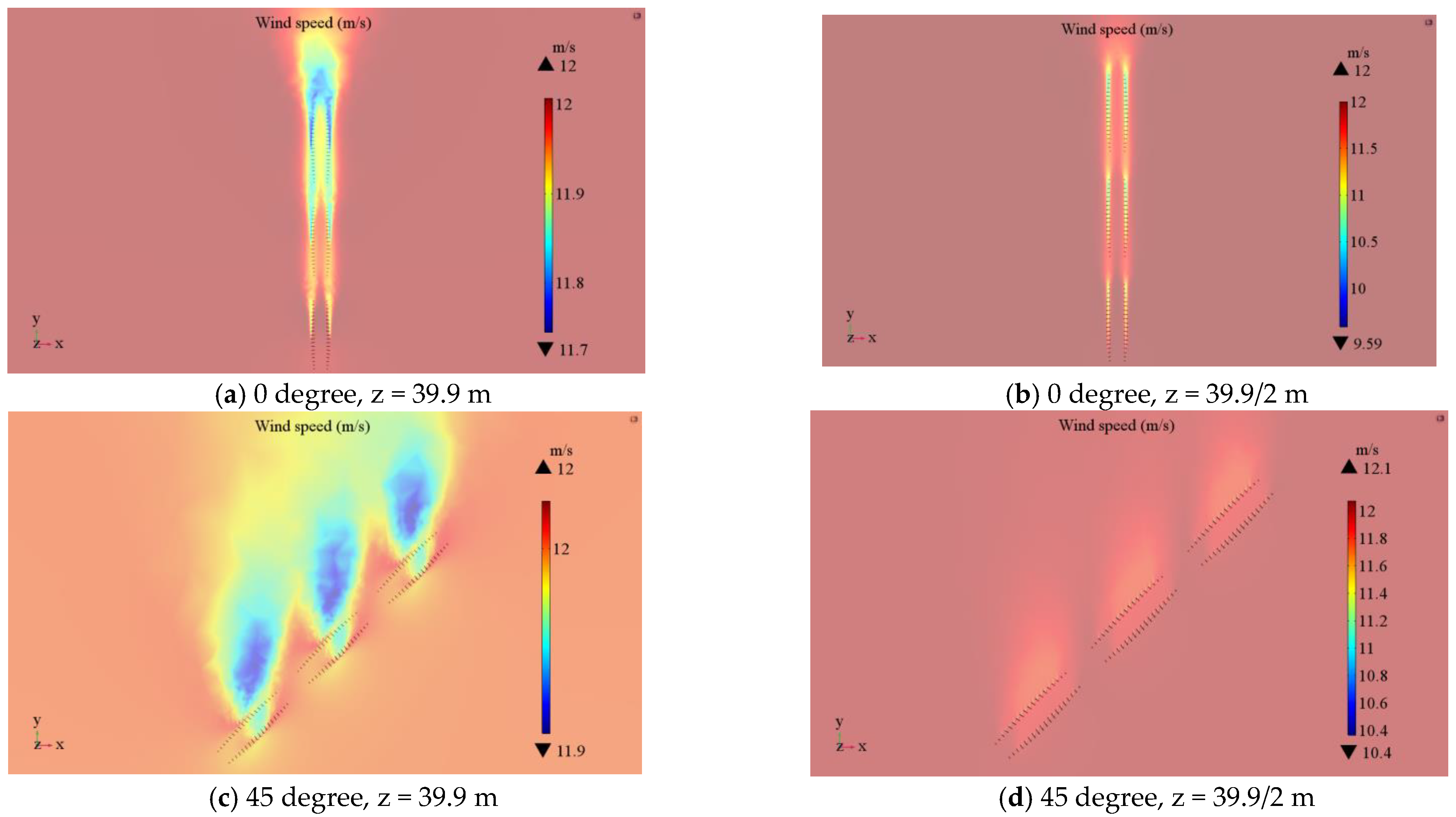Influence of Wind Speed, Wind Direction and Turbulence Model for Bridge Hanger: A Case Study
Abstract
:1. Introduction
2. Computational Fluid Dynamics
3. Calculation and Analysis
3.1. Influence of CFD Models
3.2. Influence of Wind Speed
3.3. Influence of Wind Direction
4. Discussion and Conclusions
- The calculation result of the SST k-ω model is different from that of the standard k-ε model, realizable k-ε model, and standard k-ω model, such as the wake flow characteristics of a hanger. Therefore, we will use the standard k-ε model to calculate the von Mises stress time history curve of bridge hangers and then assess the fatigue life of bridge hangers in a future work.
- The larger is the wind speed, the larger is the effect on the wind field and stress for the investigated bridge hangers. For example, when the wind speed increases from 3 to 12 m/s, the stress of the bridge hangers nonlinearly increases. Therefore, the influence of the bridge hangers should be a concern under a strong wind speed during the operation.
- Regarding the different wind directions with the same wind speed, the influence of the bridge hangers is also different. For example, when the wind direction increases from 0 to 90 degrees, the fatigue life of the bridge hangers decreases. Therefore, the influence of wind direction on the investigated bridge hangers cannot be ignored.
Author Contributions
Funding
Institutional Review Board Statement
Informed Consent Statement
Data Availability Statement
Conflicts of Interest
References
- Xu, S.Q.; Ma, R.J.; Wang, D.; Chen, A.; Tian, H. Prediction analysis of vortex-induced vibration of long-span suspension bridge based on monitoring data. J. Wind Eng. Ind. Aerodyn. 2019, 191, 312–324. [Google Scholar] [CrossRef]
- Shum, K.M.; Xu, Y.L.; Guo, W.H. Wind-induced vibration control of long span cable-stayed bridges using multiple pressurized tuned liquid column dampers. J. Wind Eng. Ind. Aerodyn. 2008, 96, 166–192. [Google Scholar] [CrossRef]
- Li, S.; Laima, S.; Li, H. Data-driven modeling of vortex-induced vibration of a long-span suspension bridge using decision tree learning and support vector regression. J. Wind Eng. Ind. Aerodyn. 2018, 172, 196–211. [Google Scholar] [CrossRef]
- Li, S.L.; An, Y.H.; Wang, C.Q.; Wang, D.W. Experimental and numerical studies on galloping of the flat-topped main cables for the long span suspension bridge during construction. J. Wind Eng. Ind. Aerodyn. 2017, 163, 24–32. [Google Scholar] [CrossRef]
- Casalotti, A.; Arena, A.; Lacarbonara, W. Mitigation of post-flutter oscillations in suspension bridges by hysteretic tuned mass dampers. Eng. Struct. 2014, 69, 62–71. [Google Scholar] [CrossRef]
- Ding, Y.; Dong, J.; Yang, T.; Zhou, S.; Wei, Y. Failure Evaluation of Bridge Deck Based on Parallel Connection Bayesian Network: Analytical Model. Materials 2021, 14, 1411. [Google Scholar] [CrossRef] [PubMed]
- Ni, Y.Q.; Xia, Y.; Liao, W.Y.; Ko, J.M. Technology innovation in developing the structural health monitoring system for guangzhou new tv tower. Struct. Control Health Monit. 2009, 16, 73–98. [Google Scholar] [CrossRef]
- Lin, L.; Chen, K.; Xia, D.; Wang, H.; Hu, H.; He, F. Analysis on the wind characteristics under typhoon climate at the southeast coast of china. J. Wind Eng. Ind. Aerodyn. 2018, 182, 37–48. [Google Scholar] [CrossRef]
- Wang, H.; Li, A.; Niu, J.; Zong, Z.; Li, J. Long-term monitoring of wind characteristics at sutong bridge site. J. Wind Eng. Ind. Aerodyn. 2013, 115, 39–47. [Google Scholar] [CrossRef]
- Xu, Y.L. Making good use of structural health monitoring systems of long-span cable-supported bridges. J. Civ. Struct. Health Monit. 2018, 8, 477–497. [Google Scholar] [CrossRef]
- Koo, K.Y.; Brownjohn, J.M.W.; List, D.I.; Cole, R. Structural health monitoring of the Tamar suspension bridge. Struct. Control Health Monit. 2013, 20, 609–625. [Google Scholar] [CrossRef] [Green Version]
- Ding, Y.; Zhou, G.; Li, A.; Deng, Y. Statistical characteristics of sustained wind environment for a long-span bridge based on long-term field measurement data. Wind Struct. 2013, 17, 43–68. [Google Scholar] [CrossRef]
- Saha, U.K.; Thotla, S.; Maity, D. Optimum design configuration of savonius rotor through wind tunnel experiments. J. Wind Eng. Ind. Aerodyn. 2008, 96, 1359–1375. [Google Scholar] [CrossRef]
- Zajaczkowski, F.J.; Haupt, S.E.; Schmehl, K.J.; Jweia, J.; Model, W.F. A preliminary study of assimilating numerical weather prediction data into computational fluid dynamics models for wind prediction. J. Wind Eng. Ind. Aerodyn. 2011, 99, 320–329. [Google Scholar] [CrossRef]
- Jeong, W.M.; Liu, S.N.; Jakobsen, J.B.; Ong, M.C. Unsteady RANS simulations of flow around a twin-box bridge girder cross section. Energies 2019, 12, 2670. [Google Scholar] [CrossRef] [Green Version]
- Matsumoto, M.; Shijo, R.; Eguchi, A.; Hikida, T.; Mizuno, K. On the flutter characteristics of separated two box girders. Wind Struct. Int. J. 2004, 7, 281–291. [Google Scholar] [CrossRef]
- Hu, C.; Zhou, Z.; Jiang, B. Effects of types of bridge decks on competitive relationships between aerostatic and flutter stability for a super long cable-stayed bridge. Wind Struct. 2019, 28, 255–270. [Google Scholar]
- Zhu, L.D.; Li, L.; Xu, Y.L.; Zhu, Q. Wind tunnel investigations of aerodynamic coefficients of road vehicles on bridge deck. J. Fluids Struct. 2012, 30, 35–50. [Google Scholar] [CrossRef]
- Montoya, M.C.; Nieto, F.; Hernández, S.; Kusano, I.; Jurado, J.Á. Cfd-based aeroelastic characterization of streamlined bridge deck cross-sections subject to shape modifications using surrogate models. J. Wind Eng. Ind. Aerodyn. 2018, 177, 405–428. [Google Scholar] [CrossRef]
- Thordal, M.S.; Bennetsen, J.C.; Koss, H.H.H. Review for practical application of cfd for the determination of wind load on high-rise buildings. J. Wind Eng. Ind. Aerodyn. 2019, 186, 155–168. [Google Scholar] [CrossRef]
- Scappaticci, L.; Castellani, F.; Astolfi, D.; Garinei, A. Diagnosis of vortex induced vibration of a gravity damper. Diagnostyka 2018, 19, 31–39. [Google Scholar] [CrossRef]
- Huang, W.; Yang, Q.; Hong, X. Cfd modeling of scale effects on turbulence flow and scour around bridge piers. Comput. Fluids 2009, 38, 1050–1058. [Google Scholar] [CrossRef]
- Shirai, S.; Ueda, T. Aerodynamic simulation by cfd on flat box girder of super-long-span suspension bridge. J. Wind Eng. Ind. Aerodyn. 2003, 91, 279–290. [Google Scholar] [CrossRef]
- Khalilzadeh, A.; Ge, H.; Ng, H.D. Effect of turbulence modeling schemes on wind-driven rain deposition on a mid-rise building: Cfd modeling and validation. J. Wind Eng. Ind. Aerodyn. 2019, 184, 362–377. [Google Scholar] [CrossRef]
- Haque, S.M.E.; Rasul, M.G.; Khan, M.M.K.; Deev, A.V.; Subaschandar, N. Influence of the inlet velocity profiles on the prediction of velocity distribution inside an electrostatic precipitator. Exp. Therm. Fluid Sci. 2009, 33, 322–328. [Google Scholar] [CrossRef]
- Sun, D.; Owen, J.S.; Wright, N.G. Application of the k–ω turbulence model for a wind-induced vibration study of 2d bluff bodies. J. Wind Eng. Ind. Aerodyn. 2009, 97, 77–87. [Google Scholar] [CrossRef]
- Xu, G.; Cai, C.S. Numerical investigation of the lateral restraining stiffness effect on the bridge deck-wave interaction under stokes waves. Eng. Struct. 2017, 130, 112–123. [Google Scholar] [CrossRef] [Green Version]
- De, M.S.; Patruno, L.; Ubertini, F.; Vairo, G. Indicial functions and flutter derivatives: A generalized approach to the motion-related wind loads. J. Fluids Struct. 2013, 42, 466–487. [Google Scholar]
- Glück, M.; Breuer, M.; Durst, F.; Halfmann, A.; Rank, E. Computation of wind-induced vibrations of flexible shells and membranous structures. J. Fluids Struct. 2003, 17, 739–765. [Google Scholar] [CrossRef]
- Santo, G.; Peeters, M.; Van Paepegem, W.; Degroote, J. Dynamic load and stress analysis of a large horizontal axis wind turbine using full scale fluid-structure interaction simulation. Renew. Energy 2019, 140, 212–226. [Google Scholar] [CrossRef]
- Wu, Y.L.; Qi, L.J.; Zhang, H.; Musiu, E.; Yang, Z.P.; Wang, P. Design of UAV downwash airflow field detection system based on strain effect principle. Sensors 2019, 19, 2630. [Google Scholar] [CrossRef] [Green Version]
- Qi, Y.H.; Ishihara, T. Numerical study of turbulent flow fields around of a row of trees and an isolated building by using modified k-ε model and les model. J. Wind Eng. Ind. Aerodyn. 2018, 177, 293–305. [Google Scholar] [CrossRef]
- Nakajima, K.; Ooka, R.; Kikumoto, H. Evaluation of k-ε reynolds stress modeling in an idealized urban canyon using les. J. Wind Eng. Ind. Aerodyn. 2018, 175, 213–228. [Google Scholar] [CrossRef]
- Lateb, M.; Masson, C.; Stathopoulos, T.; Bédard, C. Comparison of various types of k–ε models for pollutant emissions around a two-building configuration. J. Wind Eng. Ind. Aerodyn. 2013, 115, 9–21. [Google Scholar] [CrossRef] [Green Version]
- Wilcox, D.C. Reassessment of the scale-determining equation for advanced turbulence models. AIAA J. 1988, 26, 1299–1310. [Google Scholar] [CrossRef]
- Menter, F.R. Two-equation eddy-viscosity turbulence models for engineering applications. AIAA J. 1994, 32, 1598–1605. [Google Scholar] [CrossRef] [Green Version]
- Menter, F.R. Zonal two equation k-ω turbulence models for aerodynamic flows. AIAA J. 1993, 6, 2893–2906. [Google Scholar]
- Ding, Y.; Yang, T.L.; Liu, H.; Han, Z.; Zhou, S.X.; Wang, Z.P.; She, A.M.; Wei, Y.-Q.; Dong, J.L. Experimental study and simulation calculation of the chloride resistance of concrete under multiple factors. Appl. Sci. 2021, 11, 5322. [Google Scholar] [CrossRef]







Publisher’s Note: MDPI stays neutral with regard to jurisdictional claims in published maps and institutional affiliations. |
© 2021 by the authors. Licensee MDPI, Basel, Switzerland. This article is an open access article distributed under the terms and conditions of the Creative Commons Attribution (CC BY) license (https://creativecommons.org/licenses/by/4.0/).
Share and Cite
Ding, Y.; Zhou, S.-X.; Wei, Y.-Q.; Yang, T.-L.; Dong, J.-L. Influence of Wind Speed, Wind Direction and Turbulence Model for Bridge Hanger: A Case Study. Symmetry 2021, 13, 1633. https://doi.org/10.3390/sym13091633
Ding Y, Zhou S-X, Wei Y-Q, Yang T-L, Dong J-L. Influence of Wind Speed, Wind Direction and Turbulence Model for Bridge Hanger: A Case Study. Symmetry. 2021; 13(9):1633. https://doi.org/10.3390/sym13091633
Chicago/Turabian StyleDing, Yang, Shuang-Xi Zhou, Yong-Qi Wei, Tong-Lin Yang, and Jing-Liang Dong. 2021. "Influence of Wind Speed, Wind Direction and Turbulence Model for Bridge Hanger: A Case Study" Symmetry 13, no. 9: 1633. https://doi.org/10.3390/sym13091633





